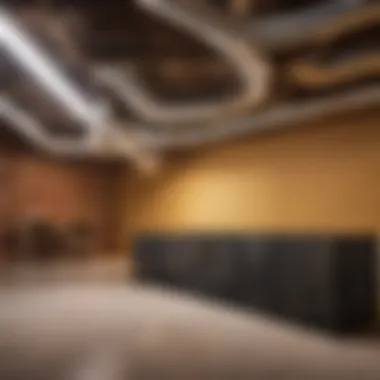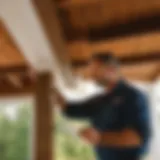Materials:
-
Duct tape: 3 rolls of 2-inch width each, to secure connections and prevent air leaks.
-
Metal shears: 1 pair for cutting and shaping the air ducts accurately.
-
Measuring tape: 1 tool for precise measurements and fitting.
-
Insulation: 2 packs of R-6 insulation for energy efficiency.
-
Gloves: 1 pair to protect hands during handling and installation.
-
Screwdriver: 1 set with various tips for securing ductwork.
DIY Steps:
-
Planning: Assess the current ductwork layout and determine the required materials for replacement.
-
Preparation: Clear the area around the air ducts and shut off the HVAC system for safety.
-
Removal: Carefully dismantle the existing air ducts, noting any damages or areas in need of repair.
-
Installation: Fit the new air ducts in place, ensuring proper alignment and sealing with duct tape.
-
Insulation: Wrap the ductwork with insulation to enhance energy efficiency and prevent heat loss.
-
Testing: Turn on the HVAC system to check for any air leaks or issues in the newly replaced ducts.
-
Finishing: Secure any loose connections and ensure the ductwork is properly installed and insulated.
Technical Aspects:
-
Tools: Use metal shears for accurate cutting, screwdrivers for fastening, and insulation for energy efficiency.
-
Timing: Allocate sufficient time for each step, ensuring precision and attention to detail.
-
Techniques: Prioritize proper sealing with duct tape and insulation to optimize air flow and energy savings.
-
Specifics: Follow manufacturer guidelines for airflow direction and connection specifications to ensure optimal performance.
Process:


Step 1 - Planning: Measure the dimensions of the existing ductwork and create a layout for the replacement.
Step 2 - Preparation: Clear away any debris or obstructions around the air ducts to allow for easy access during replacement.
Step 3 - Removal: Unscrew the connections and carefully detach the old air ducts, inspecting for any damages that may affect replacement.
Step 4 - Installation: Fit the new air ducts into place, securing with screws and sealing joints with duct tape to prevent air leaks.
Step 5 - Insulation: Wrap the ductwork with insulation, ensuring a snug fit to improve energy efficiency.
Step 6 - Testing: Switch on the HVAC system to verify proper airflow and check for any leaks in the newly replaced ducts.
Step 7 - Finishing: Double-check all connections, make any necessary adjustments, and ensure the ductwork is installed correctly for optimal performance.
Introduction


Air ducts play a vital role in maintaining the quality of indoor air and the energy efficiency of your home. Understanding when and why to replace air ducts is crucial for creating a comfortable living environment. This comprehensive guide on replacing air ducts will walk you through the essential steps to revamp your home effectively. By modernizing your air duct system, you can drastically improve the air quality in your house and reduce energy consumption.
Understanding the Importance of Air Ducts
When it comes to the functionality of air ducts, they act as the circulatory system of your home's heating, ventilation, and air conditioning (HVAC) units. Properly functioning air ducts ensure that cooled or heated air reaches every room efficiently, maintaining a consistent temperature throughout the house. The functionality of air ducts directly affects the comfort level of your indoor space, making it a crucial consideration in revamping your home.
Functionality of Air Ducts
One key characteristic of air ducts' functionality is their ability to distribute conditioned air evenly throughout your living space. This ensures that every room receives the same level of comfort, eliminating hot or cold spots. The seamless flow of air provided by well-designed ducts enhances your HVAC system's performance, leading to optimal energy efficiency and cost savings.
Signs of Damaged Air Ducts
On the other hand, damaged air ducts can result in uneven temperature distribution, increased energy bills, and poor indoor air quality. Identifying signs of damaged ductwork, such as holes, leaks, or visible deterioration, is essential for maintaining a healthy environment in your home. Addressing these issues promptly can prevent further damage and ensure efficient operation of your HVAC system.
Benefits of Replacing Air Ducts
Replacing air ducts offers a multitude of benefits that contribute to a healthier and more energy-efficient home environment. By investing in modernizing your air duct system, you can enjoy improved air quality, enhanced energy efficiency, and a reduction in allergens and pollutants.
Improved Air Quality
One of the primary advantages of replacing air ducts is the significant enhancement in indoor air quality. New ductwork eliminates the buildup of dust, mold, and other contaminants that can circulate through your home, posing health risks. With clean and well-sealed ducts, you can breathe easier and enjoy a fresher atmosphere inside your house.
Enhanced Energy Efficiency
Another key benefit of replacing air ducts is the boost in energy efficiency it provides. Upgrading to energy-efficient materials and ensuring proper insulation can reduce energy waste and lower your utility bills. By optimizing the airflow and sealing any leaks, you can maximize the performance of your HVAC system while minimizing energy consumption.
Reduction in Allergens and Pollutants
By installing new air ducts, you can effectively reduce the presence of allergens and pollutants in your home. Old ductwork can harbor dust, debris, and even mold, which can trigger allergies and respiratory issues. With clean and sealed ducts, you create a healthier living environment for you and your family, free from harmful airborne particles.
Determining the Need for Replacement


In the comprehensive guide to revamping your home by replacing air ducts, the section on Determining the Need for Replacement plays a pivotal role. It serves as the foundation for making informed decisions about whether replacing your air ducts is necessary and the benefits it can bring. By understanding the signs that indicate the need for replacement, homeowners can ensure optimal indoor air quality and energy efficiency.
Signs Indicating Replacement
Aging Ductwork
Aging ductwork is a critical aspect to consider when determining the need for replacement. Over time, air ducts can deteriorate due to constant use, leading to cracks, leaks, and reduced efficiency. Aging ductwork contributes significantly to poor indoor air quality and compromised energy efficiency, impacting the overall comfort of your home. The key characteristic of aging ductwork is its susceptibility to wear and tear, which can result in air leaks and decreased performance. While aging ductwork may seem like a cost-saving choice, it can actually lead to increased energy bills and health concerns.
Inconsistent Temperature
Another crucial sign indicating the need for air duct replacement is experiencing inconsistent temperatures throughout your home. Inconsistent temperature distribution can be a result of ductwork that is no longer functioning optimally, causing certain areas to be warmer or cooler than others. This issue can impact the comfort levels in different rooms and lead to overworking HVAC systems to compensate for the temperature disparities. Addressing inconsistent temperature through air duct replacement can improve overall heating and cooling efficiency, ensuring a more balanced and comfortable indoor environment.
Visible Damage
Visible damage on air ducts is a clear indication that replacement is necessary. Signs of visible damage can include dents, holes, or rust on the ductwork, which can compromise its functionality and structural integrity. Visible damage not only affects the performance of the air ducts but can also contribute to poor indoor air quality by allowing contaminants to enter the system. Addressing visible damage promptly by replacing damaged air ducts is essential in maintaining a healthy and efficient home environment.
Professional Inspection Importance
When it comes to determining the need for air duct replacement, the importance of professional inspections cannot be overstated. HVAC technician evaluations and assessments of ductwork condition are crucial in identifying underlying issues and recommending the appropriate course of action.
Importance of HVAC Technician Evaluation
The significance of HVAC technician evaluations lies in their expertise in diagnosing air duct problems accurately. HVAC technicians can identify issues such as leaks, blockages, and inefficiencies that may not be apparent to homeowners. This in-depth evaluation ensures that the right solutions are implemented to enhance indoor air quality and energy efficiency. Choosing professional HVAC technicians guarantees a thorough assessment of your air duct system, leading to tailored recommendations for replacement or repairs.
Assessment of Ductwork Condition
Assessing the condition of ductwork is essential in determining the need for replacement. HVAC professionals conduct detailed inspections to evaluate the age, material, and performance of air ducts. By assessing ductwork condition, technicians can pinpoint areas of concern and provide homeowners with a comprehensive overview of the system's health. This assessment enables informed decision-making, guiding homeowners towards solutions that optimize air quality and efficiency. Regular assessments also help in preventing potential issues before they escalate, ensuring the long-term functionality of the air duct system.
Preparing for Replacement
When delving into revamping your home by replacing air ducts, the preparation phase is crucial. Adequately preparing for replacement sets the foundation for a successful project execution, ensuring optimal indoor air quality and energy efficiency. This section aims to guide you through the essential elements and considerations necessary for a seamless replacement process.
Budgeting for the Project
Cost Estimates
In the realm of replacing air ducts, accurate cost estimation is paramount. Cost estimates provide a detailed breakdown of the expenses involved in the replacement project, encompassing materials, labor, and any unforeseen costs that may arise. These estimates serve as a roadmap for financial planning and help in avoiding budget overruns. By obtaining reliable cost estimates, homeowners can make informed decisions about the scope and feasibility of the replacement project. The key characteristic of cost estimates lies in their ability to provide transparency and clarity regarding financial aspects, allowing for better budget management throughout the replacement process.
Financial Planning
Financial planning plays a vital role in the success of any home improvement project, including replacing air ducts. It involves strategizing and organizing financial resources to support the replacement endeavor effectively. A well-thought-out financial plan empowers homeowners to allocate funds efficiently, prioritize expenses, and explore cost-saving opportunities without compromising on quality. The unique feature of financial planning lies in its tailored approach to aligning financial goals with the overall objective of enhancing indoor air quality and energy efficiency. While advantageous in ensuring a structured financial roadmap, meticulous financial planning requires continuous monitoring and adjustments to adapt to project variables, making it a strategic cornerstone in the replacement process.
Choosing the Right Replacement Ducts
Materials Selection
The selection of materials for replacement ducts is a critical decision that directly impacts the performance and longevity of the new system. Opting for high-quality and durable materials ensures durability, airtightness, and resistance to wear and tear. Materials such as galvanized steel, aluminum, or fiberglass offer varying benefits in terms of strength, insulation properties, and corrosion resistance. Homeowners must consider factors like climate, budget constraints, and desired efficiency levels when selecting materials for replacement ducts. The key characteristic of materials selection lies in its ability to tailor the duct system to meet specific requirements, balancing functionality and longevity effectively.
Size and Design Considerations
Size and design considerations are pivotal in optimizing the performance and efficiency of replacement ductwork. Determining the right size of ducts ensures proper airflow distribution and minimizes energy wastage. Additionally, focusing on the design elements like layout, bends, and connections enhances airflow consistency and reduces potential obstructions. Homeowners should collaborate with HVAC professionals to assess airflow requirements, space constraints, and system compatibility in selecting the optimal size and design for replacement ducts. The unique feature of size and design considerations lies in their hands-on approach to customizing ductwork for maximum efficiency and effectiveness within the home. By prioritizing these considerations, homeowners can elevate the functionality and performance of their HVAC system while enhancing overall indoor comfort.
Scheduling the Replacement
Timing and Convenience
Choosing the right timing for duct replacement is essential in ensuring minimal disruption to daily routines and maximizing convenience for occupants. Optimal timing involves considering factors such as seasonal climate variations, occupancy patterns, and personal schedules to schedule the replacement process effectively. Coordinating the replacement during favorable weather conditions or less busy periods can streamline the project timeline and enhance the overall experience for residents. The key characteristic of timing and convenience lies in its ability to minimize inconveniences and disturbances associated with the replacement process, promoting a smooth transition to the new duct system.
Coordination with Professionals
Efficient coordination with HVAC professionals is fundamental in executing a successful duct replacement project. Collaboration with experienced technicians ensures adherence to industry standards, compliance with local regulations, and accurate installation of replacement ducts. Professionals bring expertise, technical proficiency, and specialized tools to the project, guaranteeing precision and quality in the replacement process. The unique feature of coordination with professionals lies in its synergistic approach, combining homeowner input with professional guidance to achieve optimal results. While beneficial in ensuring quality workmanship, effective coordination necessitates clear communication, mutual respect, and a collaborative ethos between homeowners and professionals involved in the replacement endeavor.
Executing the Replacement Process:
Embarking on the replacement process is a crucial step when revamping your home by replacing air ducts. This section delves into the intricate process of executing the replacement, ensuring that each component aligns seamlessly for optimal performance. Attention to detail during this phase is paramount to guarantee the efficiency and longevity of the new air duct system.
Demolition of Old Ductwork:
Removal Process: The meticulous removal process involved in dismantling old ductwork plays a pivotal role in preparing for the installation of new air ducts. Integrated within this article is a detailed exploration of the removal process, highlighting the importance of methodical deconstruction to ensure a smooth transition to the new system. The removal process contributes significantly to the overall goal of enhancing indoor air quality and energy efficiency. Its unique characteristic lies in its systematic approach, reducing the risks of damage and ensuring a seamless replacement process without compromising structural integrity.
Safety Measures: As safety is paramount in any home renovation project, this article emphasizes the criticality of implementing safety measures during the ductwork demolition phase. Safety measures are essential elements woven into the replacement process to safeguard both the property and individuals involved. The incorporation of stringent safety protocols ensures a secure working environment and minimizes the potential for accidents or mishaps. The unique feature of these safety measures is their proactive nature, preempting any risks that may arise during the demolition process, thereby providing a secure foundation for the installation of new air ducts.
Installation of New Air Ducts:
Proper Fitting and Sealing: Optimal performance of the new air duct system heavily relies on the proper fitting and sealing of the ductwork. Delve into the specifics of the proper fitting and sealing process within this article, accentuating the significance of precision in this task. Proper fitting and sealing contribute indispensably to the overall objective of efficient air circulation and minimizing energy loss. The unique feature of this aspect lies in its meticulous attention to detail, ensuring airtight connections that prevent air leaks and enhance system performance.
Insulation Application: An integral part of the replacement process is the application of insulation to the new air ducts. Uncover the nuances of insulation application in this article, underscoring its impact on energy conservation and temperature regulation within the home. This process is essential for maintaining the desired indoor climate while reducing the load on heating and cooling systems. The unique feature here is the insulation's ability to improve energy efficiency by preventing temperature fluctuations and maximizing the air duct system's effectiveness.
Testing and Quality Assurance:
Airflow Assessment: Thorough airflow assessment is a critical component of ensuring the efficacy of the newly installed air ducts. Explore the intricacies of airflow assessment within this article, shedding light on its role in optimizing air distribution throughout the living space. The key characteristic of airflow assessment is its ability to identify any irregularities or blockages that may impede airflow, enabling timely interventions for enhanced system performance. This assessment method offers a proactive approach to maintaining healthy indoor air quality and maximizing energy efficiency.
Leakage Inspection: Conducting a meticulous leakage inspection post-installation is imperative to guarantee the integrity of the new air duct system. Delve into the specifics of leakage inspection in this article, emphasizing its contribution to maintaining airtight ductwork and preventing energy wastage. The unique feature of leakage inspection lies in its ability to detect even minor leaks that could compromise system efficiency, allowing for prompt rectification and optimal functionality. This inspection process plays a crucial role in ensuring long-term performance and cost-effectiveness of the air duct replacement.
After Replacement Care
After replacing air ducts in your home, maintenance and care become crucial for ensuring the longevity and efficiency of the new system. This section focuses on the pivotal aspects of post-replacement care, highlighting specific elements, benefits, and considerations.
Maintenance Guidelines
Maintenance is key to keeping your newly installed air ducts in optimal condition. Under this, two critical aspects need attention: Regular Cleaning Practices and Scheduled Inspections.
Regular Cleaning Practices
Regular cleaning practices involve periodic cleaning of ducts, vents, and filters to remove dust, debris, and allergens. This helps maintain air quality and prevents potential blockages that could reduce airflow. The key characteristic of regular cleaning is its preventive nature in maintaining a healthy indoor environment. By regularly cleaning your air ducts, you can extend their lifespan and ensure efficient operation. This practice is highly beneficial for this article as it emphasizes the importance of proactive maintenance to preserve the benefits of replacing air ducts. A unique feature of regular cleaning is its ability to enhance indoor air quality by reducing the circulation of pollutants and allergens, making it a popular choice for those seeking a clean and healthy living space.
Scheduled Inspections
Scheduled inspections involve professional assessments of the air duct system to identify any issues or potential problems early on. These inspections help in detecting leaks, blockages, or damage that could impact the system's performance. The key characteristic of scheduled inspections is their proactive nature in addressing potential issues before they escalate, thereby ensuring the efficient operation of the air ducts. This practice is popular for its ability to detect problems proactively and intervene promptly, aligning with the overarching goal of this article - maintaining optimal air quality and energy efficiency post-replacement. A unique feature of scheduled inspections is their role in preventing costly repairs by catching problems early, making them a wise choice for homeowners looking to protect their investment and ensure a well-functioning HVAC system.
Conclusion
In the realm of home improvement, the conclusion of revising and revamping your air duct system plays a pivotal role in ensuring a healthier and more energy-efficient living space. The replacement of air ducts holds significant importance as it directly impacts indoor air quality and overall comfort within your home. By investing in the replacement of air ducts, you are taking a proactive step towards enhancing your living environment.
Enhancing Your Indoor Environment
The Long-Term Benefits
Understanding the aspect of long-term benefits associated with replacing air ducts provides a profound insight into the value it brings to your home. Long-term benefits encompass a range of advantages such as prolonged efficiency, reduced energy costs, and improved air quality. By opting for modernized air duct systems, homeowners can enjoy the peace of mind knowing that their investment will yield lasting returns by creating a healthier and more comfortable indoor environment.
Investment in Home Value
An essential component of replacing air ducts is the direct impact it has on the overall value of your home. Investing in the replacement of air ducts not only enhances indoor air quality and energy efficiency but also adds to the property's market value. Homebuyers are increasingly prioritizing energy-efficient and well-maintained air duct systems, making it a valuable selling point when putting your home on the market. Additionally, the investment in home value through air duct replacements reflects a commitment to sustainability and modern living standards.
Final Thoughts
Optimizing Airflow Efficiency
Optimizing airflow efficiency through the replacement of air ducts is a fundamental aspect of creating a more comfortable living space. Improved airflow ensures balanced temperature distribution throughout your home, resulting in enhanced comfort and energy savings. By selecting the right ductwork materials and designs, homeowners can achieve optimal airflow efficiency that contributes to a more sustainable and cost-effective household.
Creating a Healthier Living Space
Creating a healthier living space through air duct replacements is a transformative process that significantly impacts the well-being of residents. By eliminating allergens, pollutants, and mold buildup in outdated ductwork, homeowners can breathe cleaner air and reduce the risk of respiratory issues. A healthier living space fosters a more comfortable and refreshing indoor environment, promoting overall wellness and quality of life for all occupants.





